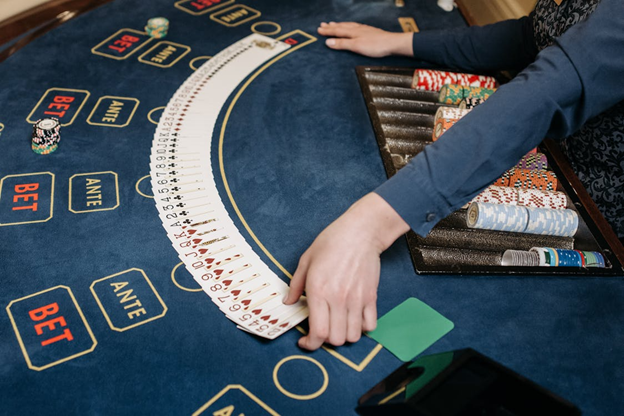At first glance, it looks deceptively simple—just choose between Banker, Player, or Draw. But underneath its polished exterior is a game rich with strategy, especially for those who thrive on probability, pattern recognition, and turn-based thinking.
In fact, that strategic overlap is why many fans of classic and modern card games are now giving baccarat a serious look. Online platforms like sawan365 have made the game more accessible than ever, and card-savvy players are starting to treat it less like a gamble and more like a battle of probability.
Let’s break it down.
Understanding the Basics—Fast
Before we get into tactics, let’s cover what actually happens in a round of baccarat.
There are two main hands: Banker and Player. You don’t control either of them—you’re simply betting on which one will win. Each hand gets two cards, sometimes a third. The hand closest to a total of nine wins. Tens and face cards count as zero, and only the last digit of the total matters (so 7 + 8 = 15 becomes 5). That’s it.
Your choices are:
● Bet on the Player to win
● Bet on the Banker to win
● Bet on a Draw
It sounds random, but the math says otherwise.
Where the Math Comes In
If you’re used to evaluating your odds in games like poker or designing optimal play routes in collectible card games, baccarat gives you room to flex that same muscle.
Here’s the quick breakdown of house edge:
● Banker: ~1.06%
● Player: ~1.24%
● Draw: ~14.4%
The edge on a Tie bet is brutally high—yet surprisingly tempting to new players because of its 8:1 (or sometimes 9:1) payout. But for anyone with a basic grasp of expected value, it's clear: Banker bets are the most efficient.
So why doesn’t everyone just bet Banker all the time? Well, for one, it’s not always fun. But more importantly, there’s nuance.
Streak Watching vs Pattern Chasing
Many baccarat players love to look for patterns—Banker streaks, alternating wins, mirror flips. If you’re from the card game world, this should raise an eyebrow. Pattern chasing without statistical backing? Sounds like playing a Magic deck based solely on your lucky sleeves.
But there’s a halfway point. Skilled players watch streaks not because they believe the shoe has a memory, but because psychological tendencies of other bettors can shift table dynamics. On platforms where community betting is visible, you’ll see people pile onto Banker during a three-win streak—not necessarily because the odds changed, but because humans love patterns.
So if you’re a rummy or bridge player who already watches what opponents are doing, this kind of behavioral edge might feel familiar.
Don’t Just Bet—Track
Treat baccarat like any good card-based system: track outcomes.
Create a simple chart:
● Mark Banker (B), Player (P), or Tie (T) per round.
● Track the current shoe (usually 6–8 decks).
● Look for outcome density, not superstition. If a shoe is 40 rounds in and the Tie has only hit once, that’s still within expected frequency.
Advanced card gamers already know how to run small sample sizes through mental probability checks. Use that same instinct here—not to “beat” the shoe, but to understand its rhythm better.
Betting Progressions That Actually Work
You’ve probably seen people at casinos double bets after every loss (Martingale) or chase outcomes after two wins. Most of these systems are traps.
But here’s a progression card game strategists might find useful:
1-3-2-6 System
● Bet 1 unit → If win, bet 3
● If win again, bet 2
● Win again, bet 6
● Any loss resets to 1
Why it works: It plays into streaks while limiting risk. And it uses clean, predictable units—something card players appreciate.
But don’t get carried away. Baccarat is still probabilistic. No betting system changes the edge; it just adjusts your exposure.
Banker Commission—Worth Factoring?
One reason people avoid Banker bets is the 5% commission. It’s deducted from winnings, which feels annoying. But here’s the math truth:
Even with commission, Banker remains the statistically strongest bet.
Let’s say you’re an old-school bridge player. You already deal with percentages and long-term averages. Treat this like another edge—slim but significant over time. The 1.06% house edge on Banker exists because of the commission. If there were none, everyone would bet Banker, and the casino wouldn’t survive.
So yes, the commission is fair. But if it bothers you, play on platforms that occasionally offer commission-free promotions. Just know the odds often rebalance in sneaky ways during those offers.
Tie Bets: Should Card Sharks Ever Touch Them?
Let’s be honest: tie bets are basically bait.
Sure, they look great with their high payouts. And yes, you’ll occasionally see patterns like:
● Banker
● Player
● Tie
● Banker
● Player
● Tie
That’s seductive, especially if you’re coming from games that reward sequence prediction.
But math doesn’t lie. Unless you have a specific reason (e.g., playing with house money and want a wild
shot), avoid it. If you must, limit it to occasional small bets layered on top of safer Banker/Player calls.
Baccarat for TCG Minds: Hidden Structure
If you love Magic: The Gathering, Yu-Gi-Oh!, or Hearthstone, here’s why baccarat might still hold your attention:
● Simple rules, complex outcomes: Like games with resource curves or draw sequencing.
● Meta without mechanics: Baccarat’s “meta” lies in bet patterns, timing, and streaks.
● Fast feedback loop: You place a bet, get results in under 30 seconds, and can iterate your approach instantly.
And because there are no hands to play, you can focus all your brainpower on betting strategy, risk management, and bankroll control.
Think of baccarat as a three-option turn-based game where every round is a fork in your decision tree. No tapping mana, no shuffling, just clean strategic choices.
Reading the Table Like You’d Read a Draft
If you’re the kind of card player who drafts in Magic or reads rummy hands like a story, baccarat can offer a similar flow—just faster.
Every table has a tempo. Some are volatile with constant swings. Others feel steady and robotic. Observing this matters. For example:
● If the table is full of aggressive Tie bettors, that might be your cue to play conservatively.
● If multiple players are using flat bets on Banker and showing wins, it may confirm statistical stability in the shoe.
Again, this isn’t magic—it’s situational awareness, and card gamers tend to be good at that.

Final Thought: Treat It Like a System, Not a Slot Machine
Card game strategists don’t like chaos—they like systems. That’s why baccarat fits.
It’s not about predicting individual outcomes. It’s about making the best choice given current information and odds, every single round.
And sure, luck plays a part. But so does mindset. The same way a poker player folds more than they bet, a solid baccarat strategist passes on high-risk moves and sticks to the long game.
So next time you’re between MTG drafts or done with your weekly rummy meet-up, consider giving baccarat a shot. It’s not just luck—it’s logic, probability, and pattern fluency in disguise.










— Comentários 0
, Reações 1
Seja o primeiro a comentar